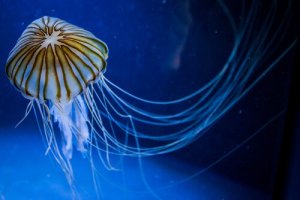Marine Life: Do All Jellyfish Sting?


Written and verified by the lawyer Francisco María García
Jellyfish are a common sight along coastlines around the world. While they typically prefer warm climates, it’s becoming increasingly common to find jellyfish in colder waters, as climate change forces certain species to migrate. In today’s article, however, we want to investigate the following question: do all jellyfish sting?
What are jellyfish?
Jellyfish are passive animals, which do not actively hunt and attack their prey. External stimuli cause their long tentacles to release nematocysts – stinging cells which release venom, protecting the animal against predators.
Armed with this defense mechanism, jellyfish let themselves drift with the current, while using their tentacles to catch food.
Only some species of jellyfish produce a venom that is dangerous to humans, and their sting isn’t usually fatal. However, jellyfish venom is nevertheless one of the most toxic in the animal kingdom.
How to avoid jellyfish stings
- As some jellyfish are entirely transparent, they can be hard to spot, making it difficult to avoid their sting. In these cases, we would recommend avoiding areas where these jellyfish have been sighted.
- There are some products which can help keep jellyfish at bay. Sunscreens, for example, are often useful for keeping jellyfish from getting too close.
- Don’t touch jellyfish, even when they’re dead. A jellyfish’s tentacles react to changes in temperature, or when they come into contact with another object. It’s important to remember that they can continue to secrete venom even after death.
Jellyfish sting prevention
The University of Israel conducted an investigation into the development of a jellyfish repellent. They began by looking at the clownfish (or anenomefish), whose skin secretes a very unusual substance. Their theory was that applying this liquid to the skin could protect the wearer against jellyfish stings.
What they found was that the substance served to confuse the jellyfish, making it think that the wearer was actually a member of its own species. As a result, it was less likely to release its venomous nematocysts.
The study showed that this product was effective in up to 85% of cases. However, it is yet to be tested against the more dangerous species, such as Physalia Physalis, commonly known as the Portuguese Man o’ War, or Chironex Fleckeri, the Sea Wasp.
Together with Oceno grafic, Isdin Laboratory also succeeded in creating a product that was effective in repelling jellyfish, thus limiting the risk of stings.
Preventative measures
Some countries have taken preventative measures to reduce jellyfish populations close to public beaches. These measures include:
- Encouraging fishing boats to catch jellyfish in the area. The problem with this method is that boats usually fish 300 ft from the shore, allowing some jellyfish to slip past them and reach the shallows.
- Anti-jellyfish nets: expert knowledge is required for this method to be effective. Small, young jellyfish can often simply pass straight through the nets. Furthermore, any dead jellyfish that run into the nets quickly start to disintegrate. Their remains can then pass through the holes in the net, often washing up in the shallows where they pose a danger to beach-goers.
How to treat a jellyfish sting
Some people recommend treating affected areas with cold water. This is often a big mistake, as the change in temperature can cause the nematocysts to fire again. This releases even more venom, causing pain and irritation to increase.
Experts advise the following:
- When a person is stung by a jellyfish, you must first try to identify the species, and not make any sudden moves.
- Move away from the animal using small, calm movements, and as much precision as possible.
- Apply salt water to the affected area. That way, there will be no great change in temperature, and the nematocysts are less likely to fire.
- After washing with saltwater, you can then rinse the area with fresh water. Apply an ice pack for 15 minutes to help alleviate the pain and reduce the affected area.
- Keep an eye on the injury over the next few days, applying antiseptic cream to prevent infection. Bandages are a good way to protect against bacteria.
This text is provided for informational purposes only and does not replace consultation with a professional. If in doubt, consult your specialist.